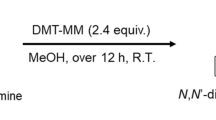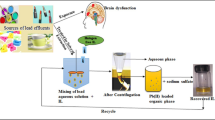Abstract
Ionic liquid (IL) assisted liquid–liquid-extraction (LLE) has been emerged as fascinating pathway to extract gallium (Ga(III)) from electronic waste. The computational investigation of LLE invokes the UNIQUAC model with extended Pitzer–Debye–Hückel (PDH*) framework to accommodate long range interactions due to the presence of ions. The combination of quantum chemical calculation and global optimization technique have been incorporated to estimate the model parameters. Herein, phosphonium and ammonium-based ILs having 26 tie-lines are used for sole Ga(III) extraction and 14 tie-lines for co-extraction. The sole Ga(III) extraction exhibits deviation between 0.5 and 0.8%, and co-extraction ranges from 0.85 to 1.5% and thus highlights the goodness of estimation.







Similar content being viewed by others
Abbreviations
- \({\mu }_{i}^\text{ext}\) \(\text{J} \cdot \text{mol}^{-1}\) :
-
Chemical potential of extract phase
- \({\mu }_{i}^\text{raf}\) \(\text{J} \cdot \text{mol}^{-1}\) :
-
Chemical potential of raffinate phase
- \({\gamma }_{i}^\text{ext}\) :
-
Activity coefficient of component in extract phase
- \({\gamma }_{i}^\text{raf}\) :
-
Activity coefficient of component in raffinate phase
- λ:
-
Extract and raffinate phase molar holdup split
- \({\gamma }_{i}^\text{comb}\) :
-
Combinatorial term
- \({\gamma }_{i}^\text{res}\) :
-
Residual term
- \({\gamma }_{i}^{\text{comb}(\infty )}\) :
-
Combinatorial term of the infinite dilution activity coefficient
- \({\gamma }_{i}^{\text{res}(\infty )}\) :
-
Residual term of the infinite dilution activity coefficient
- \({\phi }_{i}\) :
-
Volume fraction
- \({\theta }_{i}\) :
-
Surface fraction
- \({\psi }_{ji}\) :
-
Binary interaction parameter
- \({\epsilon }_\text{IL}\) :
-
Approximate dielectric constant of IL
- \({\epsilon }_{0}\) :
-
Dielectric constant value of vacuum
- \(\overline{{\epsilon }_{s}}\) :
-
Dielectric constant value for solvent
- \({\epsilon }_{i}\) :
-
Dielectric constant of components
- E :
-
Extraction efficiency
- D :
-
Distribution coefficient
- i :
-
Components
- \({f}_{i}^\text{ext}\) \(\text{mol} \cdot \text{Pa}^{-1} \cdot \text{m}^{-3}\) :
-
Fugacity of extract phase
- \({f}_{i}^\text{raf}\) \(\text{mol} \cdot \text{Pa}^{-1} \cdot \text{m}^{-3}\) :
-
Fugacity of raffinate phase
- \({x}_{i}^\text{ext}\) :
-
Mole fraction of extract phase
- \({x}_{i}^\text{raf}\) :
-
Mole fraction of raffinate phase
- L ext :
-
Molar holdup of extract stream
- L raff :
-
Molar holdup of raffinate stream
- L feed :
-
Molar holdup of feed mixture
- K i :
-
Distribution coefficient
- \(z\) :
-
Coordination number
- \({r}_{i}{,q}_{i}\) mol:
-
Structural parameters of component in UNIQUAC model
- \({r}_\text{solvent}{, q}_\text{solvent}\) mol:
-
Structural parameters of solvent in UNIQUAC model
- \({Mw}_\text{IL}\) \(\text{g} \cdot \text{mol}^{-1}\) :
-
IL molecular weight
- \(\overline{M _s}\) \(\text{g} \cdot \text{mol}^{-1}\) :
-
Solvent’s average molecular weight
- \({M}_{i}\) \(\text{g} \cdot \text{mol}^{-1}\) :
-
Molecular weight of component
- \({I}_{x}\) :
-
Ionic strength
- \({z}_{i}\) :
-
Electrovalence value of component
- \({A}_{\phi }\) :
-
Debye–Hückel parameter
- \({r}_{+}\) Å:
-
Radius of cation
- \({r}_{-}\) Å:
-
Radius of anion
- \(k\) \(\text{J} \cdot \text{K}^{-1}\) :
-
Boltzmann constant
- \({N}_\text{A}\) :
-
Avogadro’s number
- \(e\) C:
-
Electronic charge
- \(T\) K:
-
Temperature
- \(\overline{{d }_{s}}\) \(\text{g} \cdot \text{L}^{-1}\) :
-
Average density of solvent
- \({d}_{i}\) \(\text{g} \cdot \text{L}^{-1}\) :
-
Density of component
- \(C_i\), \(\text{mol} \cdot \text{L}^{-1}\) :
-
Metal concentration in the aqueous phase before extraction
- \(C_f\), \(\text{mol} \cdot \text{L}^{-1}\) :
-
Metal concentration on equilibrium after extraction performed
- \(K_\text{ex-IP}\) :
-
Ion pair extraction constant
- \(K_\text{ex-IE}\) :
-
Ion exchange extraction constant
- \(\text{Ga}^{+3}_\text{w}\), \(\text{mol} \cdot \text{L}^{-1}\) :
-
Raffinate phase gallium(III) concentration
- \(\text{Ga}^{+3}_\text{IL}\), \(\text{mol} \cdot \text{L}^{-1}\) :
-
Extract phase gallium(III) concentration
- \([{C^+}]_\text{IL}\), \(\text{mol} \cdot \text{L}^{-1}\) :
-
Concentration of the IL’s cation
- \([ {A^- }]_\text{IL}\), \(\text{mol} \cdot \text{L}^{-1}\) :
-
Concentration of IL’s anion
- \(K_\text{sp}\) :
-
Solubility product
References
Gladyshev, S.V., Akcil, A., Abdulvaliyev, R.A., Tastanov, E.A., Beisembekova, K.O., Temirova, S.S., Deveci, H.: Recovery of vanadium and gallium from solid waste by-products of Bayer process. Miner. Eng. 74, 91–98 (2015). https://doi.org/10.1016/j.mineng.2015.01.011
Nayak, S., Devi, N.: Separation and recovery of gallium(III) ions from aqueous phase by liquid–liquid extraction using a novel extractant, Cyphos IL 101. Turk. J. Chem. 41, 892–903 (2017). https://doi.org/10.3906/kim-1612-37
Song, S.J., Le, M.N., Lee, M.S.: Separation of gallium(III) and indium(III) by solvent extraction with ionic liquids from hydrochloric acid solution. Processes. 8, 1347 (2020). https://doi.org/10.3390/pr8111347
Nguyen, T.H., Lee, M.S.: A review on separation of gallium and indium from leach liquors by solvent extraction and ion exchange. Miner. Process. Extr. Metall. Rev. 40, 278–291 (2019). https://doi.org/10.1080/08827508.2018.1538987
Lu, F., **ao, T., Lin, J., Ning, Z., Long, Q., **ao, L., Huang, F., Wang, W., **ao, Q., Lan, X., Chen, H.: Resources and extraction of gallium: A review. Hydrometallurgy 174, 105–115 (2017). https://doi.org/10.1016/j.hydromet.2017.10.010
Swift, E.H.: A new method for the separation of gallium from other elements. J. Am. Chem. Soc. 46, 2375–2381 (1924). https://doi.org/10.1021/ja01676a004
Hoang, A.S., Nguyen, H.N., Quoc Bui, N., Vu, H.S., Vo, T.P., Nguyen, T.V., Minh Phan, C.: Extraction of gallium from Bayer liquor using extractant produced from cashew nutshell liquid. Miner. Eng. 79, 88–93 (2015). https://doi.org/10.1016/j.mineng.2015.05.012
Rogers, R.D., Seddon, K.R.: Ionic liquids–solvents of the future? Science 302, 792–793 (2003). https://doi.org/10.1126/science.1090313
Sheldon, R.A.: Green solvents for sustainable organic synthesis: State of the art. Green Chem. 7, 267 (2005). https://doi.org/10.1039/b418069k
Plechkova, N.V., Seddon, K.R.: Applications of ionic liquids in the chemical industry. Chem. Soc. Rev. 37, 123–150 (2008). https://doi.org/10.1039/B006677J
Liu, S., **ao, J.: Toward green catalytic synthesis—transition metal-catalyzed reactions in non-conventional media. J. Mol. Catal. A 270, 1–43 (2007). https://doi.org/10.1016/j.molcata.2007.01.003
Anastas, P.T., Crabtree, R.H. (eds.): Handbook of Green Chemistry. Wiley-VCH, Weinheim (2009)
Kroschwitz, J.I., Seidel, A. (eds.): Kirk–Othmer Encyclopedia of Chemical Technology. Wiley-Interscience, Hoboken (2004)
Zhang, S., Sun, N., He, X., Lu, X., Zhang, X.: Physical properties of ionic liquids: Database and evaluation. J. Phys. Chem. Ref. Data 35, 1475–1517 (2006). https://doi.org/10.1063/1.2204959
Armand, M., Endres, F., MacFarlane, D.R., Ohno, H., Scrosati, B.: Ionic-liquid materials for the electrochemical challenges of the future. Nat. Mater. 8, 621–629 (2009). https://doi.org/10.1038/nmat2448
Zhao, H., **a, S., Ma, P.: Use of ionic liquids as ‘green’ solvents for extractions. J. Chem. Technol. Biotechnol. 80, 1089–1096 (2005). https://doi.org/10.1002/jctb.1333
Watanabe, Y., Araki, Y., Katsuta, S.: Extraction behavior of gold(III) from hydrochloric acid solutions by protic ionic liquids. Bunseki Kagaku 63, 563–567 (2014). https://doi.org/10.2116/bunsekikagaku.63.563
Boudesocque, S., Mohamadou, A., Dupont, L.: Efficient extraction of gold from water by liquid–liquid extraction or precipitation using hydrophobic ionic liquids. New J. Chem. 38, 5573–5581 (2014). https://doi.org/10.1039/C4NJ01115E
Nguyen, V.T., Lee, J., Jeong, J., Kim, B.-S., Cote, G., Chagnes, A.: Extraction of gold(III) from acidic chloride media using phosphonium-based ionic liquid as an anion exchanger. Ind. Eng. Chem. Res. 54, 1350–1358 (2015). https://doi.org/10.1021/ie5045742
Brennecke, J.F., Maginn, E.J.: Ionic liquids: Innovative fluids for chemical processing. AIChE J. 47, 2384–2389 (2001). https://doi.org/10.1002/aic.690471102
Ganguly, A., Bairagya, P., Banerjee, T., Kundu, D.: Application of nature-inspired algorithms with generalized Pitzer–Debye–Hückel (PDH) refinement for liquid liquid equilibria (LLE) correlation in cyclic di-ether systems. AIChE J. (2022). https://doi.org/10.1002/aic.17434
Bairagya, P., Kundu, D., Banerjee, T.: A priori prediction of complex liquid–liquid–liquid equilibria in organic systems using a continuum solvation model. Phys. Chem. Chem. Phys. 22, 22023–22034 (2020). https://doi.org/10.1039/D0CP03225E
Banerjee, T., Singh, M.K., Sahoo, R.K., Khanna, A.: Volume, surface and UNIQUAC interaction parameters for imidazolium based ionic liquids via polarizable continuum model. Fluid Phase Equilib. 234, 64–76 (2005). https://doi.org/10.1016/j.fluid.2005.05.017
Brierley, J.A., Brierley, C.L.: Present and future commercial applications of biohydrometallurgy. Hydrometallurgy 59, 233–239 (2001). https://doi.org/10.1016/S0304-386X(00)00162-6
Ravilla, U.K., Banerjee, T.: Liquid liquid equilibria of imidazolium based ionic liquid+pyridine+hydrocarbon at 298.15K: experiments and correlations. Fluid Phase Equilib. 324, 17–27 (2012). https://doi.org/10.1016/j.fluid.2012.03.023
Katsuta, S., Watanabe, Y., Araki, Y., Kudo, Y.: Extraction of gold(III) from hydrochloric acid into various ionic liquids: relationship between extraction efficiency and aqueous solubility of ionic liquids. ACS Sustain. Chem. Eng. 4, 564–571 (2016). https://doi.org/10.1021/acssuschemeng.5b00976
Naik, P.K., Kundu, D., Bairagya, P., Banerjee, T.: Phase behavior of water–menthol based deep eutectic solvent–dodecane system. Chem. Thermodyn. Therm. Anal. 3–4, 100011 (2021). https://doi.org/10.1016/j.ctta.2021.100011
Acknowledgements
The corresponding author, i.e., Dr. Debashis Kundu, had optimized the molecular structures, PCM calculation and generated the COSMO files while pursuing his Doctoral studies at the Department of Chemical Engineering, Indian Institute of Technology Guwahati under the guidance of Prof. Tamal Banerjee. Hence, the authors gracefully acknowledge the contribution of Prof. Tamal Banerjee (Department of Chemical Engineering, Indian Institute of Technology Guwahati) for mentoring Dr. Debashis Kundu to accomplish the geometry optimized structures (Gaussian 09) and COSMO files (Gaussian 03) of the respective compounds.
Funding
This research did not receive any specific grant from funding agencies in the public, commercial, or not-for profit sectors.
Author information
Authors and Affiliations
Contributions
AVT: Computational Methodology, Formal analysis, Investigation, Data curation, Writing—original draft, Writing Revised Draft. DK: Conceptualization, Resources, Visualization, Supervision, Funding acquisition, Writing—review & editing.
Corresponding author
Ethics declarations
Conflict of interests
We wish to confirm that there are no known conflicts of interest associated with this publication.
Additional information
Publisher's Note
Springer Nature remains neutral with regard to jurisdictional claims in published maps and institutional affiliations.
Supplementary Information
Below is the link to the electronic supplementary material.
Rights and permissions
Springer Nature or its licensor (e.g. a society or other partner) holds exclusive rights to this article under a publishing agreement with the author(s) or other rightsholder(s); author self-archiving of the accepted manuscript version of this article is solely governed by the terms of such publishing agreement and applicable law.
About this article
Cite this article
Thombre, A.V., Kundu, D. UNIQUAC-ext-PDH* Framework for the Ionic Liquid Assisted Extraction of Gallium (III). J Solution Chem (2024). https://doi.org/10.1007/s10953-024-01365-9
Received:
Accepted:
Published:
DOI: https://doi.org/10.1007/s10953-024-01365-9




